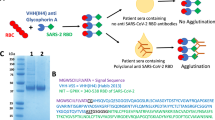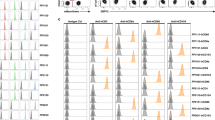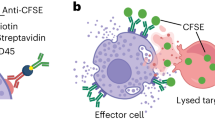Abstract
THE plaque techniques of Jerne et al.1 and of Ingraham and Bussard2 for assaying single antibody-producing cells involve the lysis of erythrocytes suspended in three dimensions around the active cells in a supporting medium, agar or methyl cellulose. Maximum sensitivity with this system would be expected if a single layer of lymphoid cells and target erythrocytes was examined. A method has been devised which dispenses with supporting media and allows detection of cells producing antibody sufficient to lyse only 10–20 adjacent erythrocytes.
This is a preview of subscription content, access via your institution
Access options
Subscribe to this journal
Receive 51 print issues and online access
$199.00 per year
only $3.90 per issue
Buy this article
- Purchase on Springer Link
- Instant access to full article PDF
Prices may be subject to local taxes which are calculated during checkout
Similar content being viewed by others
References
Jerne, N. K., Nordin, A. A., and Henry, C., in Cell-bound Antibodies, edit. by Amos, B., and Koprowski, H., 109 (Wistar Inst. Press, Philadelphia, 1963).
Ingraham, J. S., and Bussard, A., J. Exp. Med., 119, 667 (1964).
Halliday, W. J., and Webb, M., Austral. J. Exp. Biol. Med. Sci., 43, 163 (1965).
Smith, J. B., and Cunningham, A. J. (to be published).
Author information
Authors and Affiliations
Rights and permissions
About this article
Cite this article
CUNNINGHAM, A. A Method of Increased Sensitivity for detecting Single Antibody-forming Cells. Nature 207, 1106–1107 (1965). https://doi.org/10.1038/2071106a0
Published:
Issue Date:
DOI: https://doi.org/10.1038/2071106a0
This article is cited by
-
Pheromone of grouped female mice impairs genome stability in male mice through stress-mediated pathways
Scientific Reports (2023)
-
Synthesis of Glycyrrhizic Acid Conjugates with Amino-Acid Methyl Esters and their Ability to Stimulate Antibody Genesis in Mice
Pharmaceutical Chemistry Journal (2022)
-
Immunomodulating Activity of Extract of Gentiana Algida Pall.
Pharmaceutical Chemistry Journal (2017)
-
Variability of whipworm infection and humoral immune response in a wild population of mole voles (Ellobius talpinus Pall.)
Parasitology Research (2016)
-
Immunotropic Properties of Immobilized Interferon-α2b
Bulletin of Experimental Biology and Medicine (2016)
Comments
By submitting a comment you agree to abide by our Terms and Community Guidelines. If you find something abusive or that does not comply with our terms or guidelines please flag it as inappropriate.



